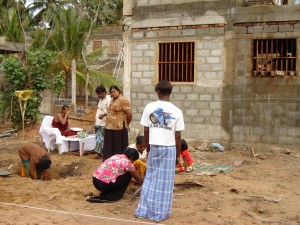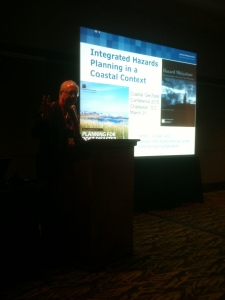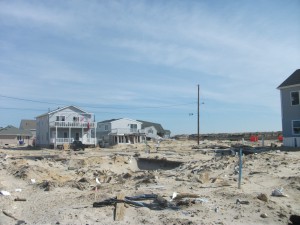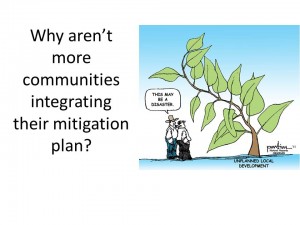
Sri Lankans dedicate new housing built in 2005, after the Indian Ocean tsunami, in a Buddhist ceremony.
One benefit of increased attention to hazards and climate change within the planning profession is a growing array of valuable literature that can benefit practicing planners and widen the scope of thinking on the subject among academics. This review of books published within the past year or so is intended to highlight some of this new literature and offer some comparisons on the focus and practical value the authors provide.
Because urban planning is ultimately about people and the built environment, it may make sense to start this survey with two books that examine the context within which risk happens. Kathleen Tierney, a professor of sociology at the University of Colorado in Boulder and director of the Natural Hazards Center there, sets out in The Social Roots of Risk: Producing Disasters, Promoting Resilience (Stanford University Press, 2014) to reorient our thinking away from the idea that individual natural phenomena—earthquakes, hurricanes, floods, etc.—“cause” the death and destruction that we often associate with them. In fact, she says, the death and destruction, particularly in the modern world, is an artifact of the social decisions that produce and, equally important, distribute risk differentially among populations, often producing widely varying impacts. In the opening chapter, she states, “the organizing idea for this book is that disasters and their impacts are socially produced, and that the forces driving the production of disaster are embedded in the social order itself.”
By itself, the idea that disaster losses result from the collision of natural forces with the built environment should not surprise any planners with a modicum of intelligence. And the built environment is inevitably the result of both individual and community decisions. The devil of Tierney’s thesis lies in the details: paying attention not only to all the social, institutional, and political decisions that either enhance or mitigate risk but to how those decisions get made and for what reasons. It is clear that those impacts are anything but randomly distributed and that most are avoidable, yet the litany of losses marches on. Tierney notes that a great deal of professional attention in recent decades has focused on how people perceive risk, a legitimate area of inquiry, but not nearly as much has focused on the origins of risk and how it was socially constructed. There are reasons, after all, why a 7.0 magnitude earthquake in Haiti kills an estimated 300,000 (but who really knows?) yet only dozens at most in California, and why the 1,800 who died during Hurricane Katrina included overwhelmingly disproportionate numbers of the economically disadvantaged.
Most planners work in local or regional government, and they serve power structures that must make the decisions, even when they choose to do nothing, that affect these outcomes. In that sense, some of Tierney’s theories and conclusions may challenge our comfort zones because they imply (or state directly) a need to challenge power with regard to these issues. For precisely that reason, I recommend reading it. Most social progress results from stepping outside traditional comfort zones. For planners, it is also within our ethical and legal responsibilities to help protect public health, safety, and welfare.
Those who wish to examine more closely how differential risk affects more vulnerable subsections of community populations can follow up with a case in point provided by Michael R. Greenberg, professor at the Edward J. Bloustein School of Planning and Public Policy at Rutgers in New Jersey, where he had a front-row seat to observe Superstorm Sandy in 2012. As a baby boomer with aging parents, he says, the event inspired him to examine the issues such events pose for seniors. Protecting Seniors Against Environmental Disasters: From Hazards and Vulnerability to Prevention and Resilience (Routledge, 2014) closely dissects the vulnerabilities of the rising generation of seniors among baby boomers. It exposes the resulting collision of demographics with natural hazards and often inadequate public policy in considering the reduced resilience that may result. At the same time, he notes that many seniors in good mental and physical health can become assets in using their to help build the very resilience many communities will need in coming decades, if only their communities learn to focus these social resources to address and help solve such problems. My only regret after reading this thoughtful book is that the publisher chose to make it so expensive ($145 hardcover), but perhaps a library or electronic copy can make it more accessible.
Six authors, mostly at Texas A&M University (TAMU) have addressed the question of resilience head-on in Planning for Community Resilience: A Handbook for Reducing Vulnerability to Disasters (Island Press, 2014). Jamie Hicks Masterson, program director of Texas Target Communities (TAMU); Walter Gillis Peacock, professor in the Department of Landscape Architecture and Urban Planning and director of the Hazards Reduction & Recovery Center (TAMU); Shannon S. Van Zandt, associate professor in the department and director of the Center for Housing and Urban Development (TAMU); Himanshu Grover, assistant professor in the Department of Urban Planning and Regional Planning at the University of Buffalo; Lori Feild Schwarz, comprehensive planning manager for the City of Plano, Texas (and formerly in Galveston); and John T. Cooper, Jr., associate professor of practice in the same department at TAMU, have combined somehow to produce an almost seamless document that lays out a very practical approach to understanding and developing resilience within communities. The book is littered with tables, checklists, and exercises to walk planners and city officials through the necessary analysis to grasp the impacts of everyday planning decisions in connection with natural hazards. The book tends to rely heavily on the Texas and Gulf Coast experiences of the authors, but as they note with a wry sense of humor, “We like to say that if you can plan in Texas, you can plan anywhere.” For the practicing planner, this may well be the most useful of the five books reviewed here.
Two other books represent the rising level of interest among planners in addressing the impacts of climate change, a subject implicit, and sometimes explicitly expressed, in the three books noted above. One of these, Local Climate Action Planning (Island Press, 2012), by Michael R. Boswell, Adrienne I. Greve, and Tammy L. Seale, is actually three years old but still a very useful and well-informed primer for those planners and city officials undertaking to address climate change. The primary focus is actually not hazards but climate action plans, which focus on mitigating climate change by using public policy and planning to reduce greenhouse gas emissions. For climate change skeptics, it is worth noting that many of the resulting strategies have local environmental and economic benefits that add to the allure of effective climate action plans. While much of the book addresses techniques like inventorying local greenhouse gas emissions and developing reduction strategies, nonetheless, the authors devote one chapter to climate adaptation and outline means of assessing community sectors for vulnerability to climate change impacts.
Finally, Adapting to Climate Change: Lessons from Natural Hazards Planning (Springer, 2014), assembled from a variety of contributions by editors Bruce C. Glavovic, of New Zealand’s Massey University, and Gavin P. Smith, of the University of North Carolina at Chapel Hill, brings together the subjects of climate and natural hazards in a way that points to future successes in addressing the increased vulnerabilities associated with climate change. Unlike the other books, it is less a single narrative than an anthology using examples of climate change adaptation from around the world. It is unquestionably the most cosmopolitan and far-reaching of the five books in its aspirations for global relevance, using case studies from South Africa, Peru, New Zealand, and the South Pacific, among other locations, in addition to the United States. The two editors first met while working in different capacities along the Gulf Coast after Hurricane Katrina and have collaborated periodically ever since. Both have been anxious to explore and explain the critical roles of planning and governance in managing exposure to natural disasters, especially as “practitioners from diverse backgrounds . . . are faced with the grand challenge of adapting to climate change. Planners who like to mine the experience of other cities and regions in case studies will find plenty to contemplate as they review the mixed international track record of community resilience in facing floods, coastal storms, and other weather-related phenomena influenced by a changing global climate with its wide-ranging variations in specific local settings. It may take a while to digest this substantial book, but it is probably well worth the effort.
Jim Schwab







